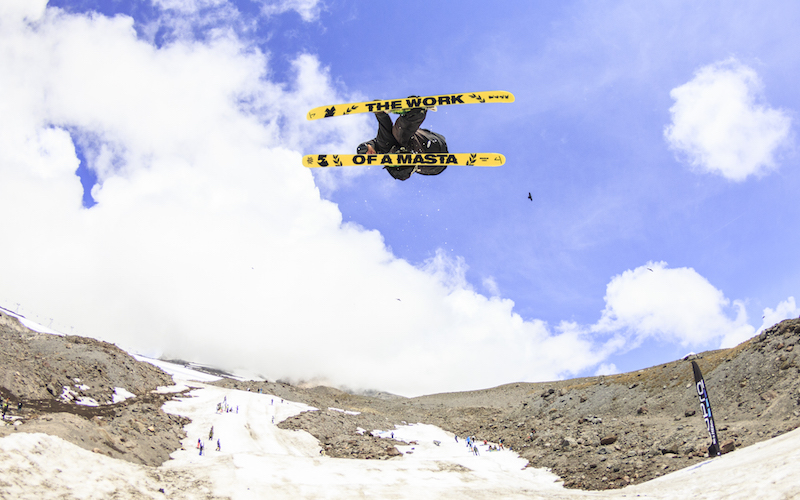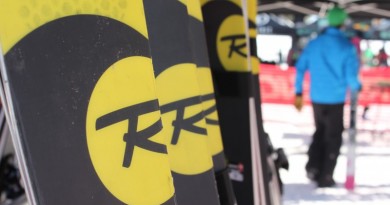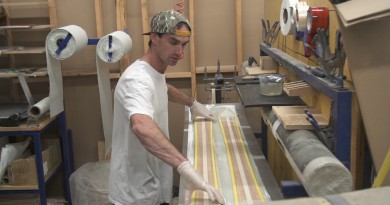Jason Levinthal changes skiing – again
Last summer, Jason Levinthal, a 42-year-old from Burlington, Vt., stood in a high school auditorium in Worcester, Mass. and recounted a story he’s told many times as part of a TEDx talk; how he looked around at the state of skiing and decided to try something different.
In the 1990s, Burton’s first snowboards were taking the slopes by storm but the skis of the day relied on the same tired old designs. The biggest ski brands were in desperate need of a breath of fresh air.
“There was this constant excitement around snowboarding that didn’t exist in skiing,” he says. For his senior design project at the University of Buffalo, Levinthal used a press he built himself to create a pair of skis that were half the width of a snowboard and had twin tips. In one afternoon on snow, he found he was able to ski switch, slide rails and spin off of jumps—far more than his straight and narrow Rossis could.
Levinthal brought his prototype and his company, Line skis, to the Ski Industry of America Convention in Las Vegas in the winter of 1996. Shortly after, he received an order from a Japanese distributor to produce 1,000 pairs. After graduating from college, he practically lived out of a warehouse for a summer, working nonstop to fill that first order.
When ski manufacturer Salomon began producing its own twin-tipped skis and marketing them, the rest of the ski industry took notice. And as the X Games began to include skiing as a slopestyle event (Levinthal took bronze in 1998), this new form of skiing drew even more attention.
Levinthal sold Line to K2 in 2006, and continued to serve as Line’s president for seven years, developing and releasing every kind ski product, including Full Tilt boots, which used articulated parts inspired by the first space suits.
In 2013, Levinthal left with the idea to try something new: a small company of his own, simply named “J,” that would sell high quality skis directly to the skier, bypassing reps and shops. This was a significant departure from the business model of larger companies. By Christmas, he designed a prototype with the help of some trusted professionals: Francois Sylvain, a ski engineer who worked on Line skis from 1999 to 2007 and designer Mark “Fank” Fankhauser, who has produced graphics for Line Skis and Ride Snowboards.
Levinthal’s first two models of skis included the 90mm waist Whipit and the 98 mm waist Allplay. The skis’ construction features pre-cured, pre-stretched carbon fiber laminates and maple and aspen cores. This keeps the skis energetic, lightweight and extremely shock absorbent, while also holding the binding screws securely. For added durability and shock absorption, the skis feature full-height sidewalls and the thickest edges available on the market—2.5 mm by 2.5 mm.
These top-quality materials are popular among many leading brands, but by selling each pair of skis directly to the consumer, Levinthal cuts out the middleman and keeps the price tag low; a pair of J’s cost between $550 and $700 compared to a pair of new skis from other brands that can cost upwards of $800.
Last year, Levinthal raised just over $42,000 through crowdfunding on Kickstarter to begin production of “The Friend,” a wider, 114 mm waist ski for those soft or deep days. Recently, J’s first-ever pair of powder-spec skis won an Official Selection award from Skiing Magazine.
The first production run of The Friend sold out and this year, in addition to bringing it back, J has released two more models: the Vacation, a 106 mm free-ride ski inspired by pro skier Giray Dadali and The Metal, which features similar specs as the Vacation, but with a titanal metal laminate in the core for a powerful and responsive ride. The Metal is Levinthal’s first design to claim awards from Backcountry Magazine, Freeskier, Powder and Skiing in the same year.
Levinthal produces as unique a ski as you can find with graphics that may feature cats in space, bikini models, Canadian flags, super villains and even special collaborations with East Coast stoke generator, Ski The East. Only 90 to 100 pairs of each graphic are produced and Levinthal initials every pair of skis he ships.
Customers supply their input on J’s new graphics or designs via Twitter, Facebook or Instagram. By using social media for marketing and keeping his operations as small as he can, Levinthal is able to keep costs down and interact directly with the people using his skis.
“Nobody needs more of the same thing,” he says. “You absolutely have to think different.” Cost: $549-$749. www.jskis.com.





Pingback: Vermont's New Microskieries - VT SKI + RIDE